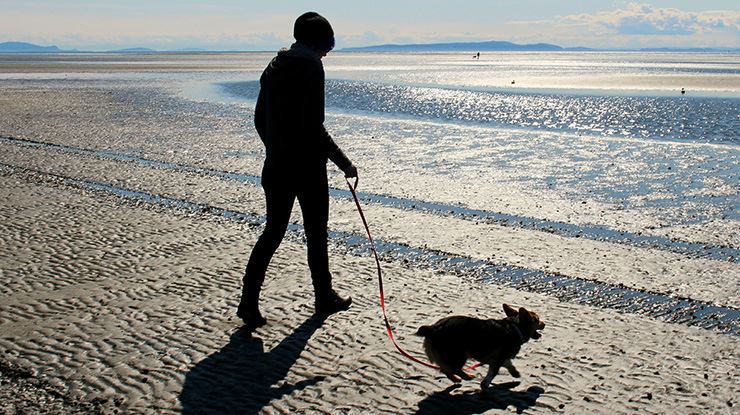
10 Tips for Teaching Your Dog To Heel
We’ve all seen her—the lady who walks that mop of a mutt on a retractable leash every morning. And we’re being generous in our use of “walk” in describing her routine, because we all know she’ll end up—at best—with one leg lassoed and knotted to a tree with the extra yards of leash and an arm pulled out of socket, if she’s lucky.
Every day her life expectancy drops.
It’s only a matter of time before the dog pulls her into traffic.
A little training in come and heel could prevent this whole mess. But the most tragic part is that she won’t retrain herself, and she and her dog are suffering because of it.
What Is Heel?
“Heel” describes the way your dog walks in relation to you. Heel means that your dog will walk near your side, with you leading the way, with or without a leash, though you may appreciate having the extra control of a leash if your dog is learning heel for the first time. The leash’s tension should be relaxed since your dog should be walking at your side instead of pulling ahead. It’s up to you to determine the walk’s pace, and, with proper training, your dog will soon get used to following your lead.
Training
You need treats.
Period.
Treats can be a vital tool for first-time training. And you’ll need an area that’s quiet and free of distractions. Begin the training by standing with your dog at your side. Once your dog has been told in a confident tone to “heel,” lead your dog by walking forward a few steps, but make sure your dog stays at your side. After walking a few steps together, reward your dog with “good heel” and a treat. Have treats that are small enough to be given continuously for the first few attempts, since repetition is key to a dog's understanding and adoption of the new skill.
After a consistent number of successes at longer distances, the next step is to begin slowly fading the treats. Continue the exercise, but use praise instead of a treat after a successful completion. Continue to give your dog treats intermittently throughout the training process, but try to steadily lengthen the time between one treat to the next. After a while, start using praise intermittently like the treats, so that your dog becomes used to heeling more out of habit than for reward. Talk to your dog, sing, or hum. Keep your dog’s attention and interest, and your dog will automatically want to stay by your side during walks.
Once the dog appears to have a firm understanding of heel, increase the challenge. Train the next level of focus in areas with more distractions, like a neighborhood, park, or large pet store. Reintroduce high-value treats into the training exercise in order to keep him focused on his task. Much like the initial training, gradually fade the treats for successful performances in larger, more populated areas.
A dog that can heel in public will be better-equipped to deal with situations like speeding vehicles, running cats, and other potential problems. But, it’s always the owner’s responsibility to be a fair, loving leader the dog will respect and obey.
Nobody's Perfect
Like any other living creature, dogs will make mistakes. Your dog may take a step backwards during training and forget what he is supposed to be doing. But don’t penalize him for forgetting; instead, return to an earlier point in the training, patiently working with your dog to make sure he has a solid understanding of each step.
Work at a pace that your dog is comfortable with, whether that means days or weeks of training. Ultimately, if you’re able to successfully train your dog to heel, those initial days and weeks of training will translate into a useful ability that will, with continued practice, last a lifetime.
What You’ll Need
leash (recommended, especially for areas without fencing)
safe area, free of distractions
high-value food rewards (Dogs, like most humans, tend to be more motivated when the promise of a bigger “paycheck” is involved. Think meat, peanut butter, or high quality dog treats.)
Hold the reward in your palm and secure it with your thumb. Remove your thumb and cup your hand to deliver the reward. This form will keep your dog from stealing the reward before it is offered and will also keep your fingertips safe from accidental bites.
Cheat Sheet
1. Sit at my side.
Start with the dog sitting at your side. (If you need to keep your hands free for rewarding, try tying the leash’s end securely around your waist.)
2. Reward ready.
Place a high-value food reward in the palm of your hand (secured with your thumb).
3. Tempt to train.
Hold the reward in front of dog’s nose, palm facing the dog. (You’re tempting the dog into training.)
4. Start the walk.
Say “heel” and begin walking with the reward leading the dog at your side. Your palm (as part of your arm) will remain by your side in the same proximity that the dog’s nose should be when heeling.
5. Treat, treat, treat.
As the dog follows the reward hand, treat continuously while saying “good heel.” (A clicker may also be used to capture the moment of success, if desired.) Do not acknowledge unsuccessful heels with “good heel,” as this will confuse the dog’s understanding of a successful execution. If heeling is not successful, be patient and refer back to an earlier step to try the sequence again.
6. Baby steps.
Start with intervals of only a few steps at a time, treating continuously while moving and praising success with “good heel.”
7. Walk a little longer.
Slowly build to longer distances (several yards). Continue treating and giving the heel command followed by “good heel” for successful heels.
8. Work a little harder.
After mastering several yards of successful heel repetitions, add more distance and stagger treats (treating less often). Continue using verbal cues (“heel” and “good heel”) during the process.
9. Fade the paycheck.
Eventually fade the treats. Try walking the length of a football field (or several laps around the backyard) while giving the heel command. This will test skill mastery. Always praise success at the end of a mastered skill.
10. Change the setting.
Add a little more distraction, at a dog park or around the neighborhood, to test the dog’s focus and obedience in heeling.
Anticipate trouble!
Preparing for failure boosts the chances of success.
1. For dogs that need a little more encouragement to heel, slather a spatula in peanut butter and hold it at your side as you begin teaching the heel sequence. Few dogs can resist a free lick of peanut butter.
2. Walk at a brisker pace to keep your dog’s attention captive. Distraction and boredom can strike even the best of dogs, and slower paced walking gives too much “loose time” for dogs to become unfocused.
3. Watch your dog’s body language. Her muscles and her gaze will reveal whether she is about to break focus. When the warning signs of distraction first appear, quickly pivot and change your direction. This should jolt her back to focusing on you and the skill.
4. If she’s having extra trouble focusing, your dog may need a brain break. Pause for a minute and test another (previously mastered) skill, like sit. This gives you both a break from the current lesson while strengthening skills in her repertoire, and allows an opportunity for a fresh reward.
Final Tips
Sometimes: Go back to previous steps in the sequence to retrain.
Always: Remain patient, consistent, and calm.
Never: Pull your dog’s leash violently or strike your dog in order to force a heel.












